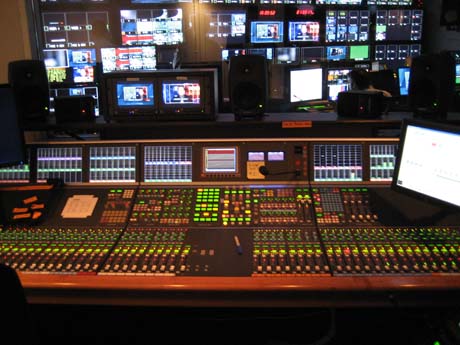|
Phantom Center
{{Unreferenced, date=December 2007 Phantom center refers to the psycho-acoustic phenomenon of a sound source appearing to emanate from a point between two speakers in a stereo configuration. When the same sound arrives at both ears at the same time with the same intensity, it appears to originate from a point in the center of the two speakers. A difference in intensity (volume) will cause the sound to appear to come from the louder side. Similarly, if a sound arrives at one ear before the other (no later than approximately 30 ms, see Precedence effect), it will appear to originate from that side. The ear–brain system evolved to use these cues to determine the location of sounds, an important evolutionary advantage. Frequency variations can also affect perceived directivity of sound. Therefore the tightness of the stereo field (and hence phantom center image) is highly dependent on the frequency response of the speakers producing it being matched as closely as possible. Thes ... [...More Info...] [...Related Items...] OR: [Wikipedia] [Google] [Baidu] |
Precedence Effect
The precedence effect or law of the first wavefront is a binaural psychoacoustical effect. When a sound is followed by another sound separated by a sufficiently short time delay (below the listener's echo threshold), listeners perceive a single auditory event; its perceived spatial location is dominated by the location of the first-arriving sound (the first wave front). The lagging sound also affects the perceived location. However, its effect is suppressed by the first-arriving sound. The Haas effect was described in 1949 by Helmut Haas in his Ph.D. thesis. It is often equated with the underlying precedence effect. History Joseph Henry published "On The Limit of Perceptibility of a Direct and Reflected Sound" in 1851. The "law of the first wavefront" was described and named in 1948 by Lothar Cremer. The "precedence effect" was described and named in 1949 by Wallach et al. They showed that when two identical sounds are presented in close succession they will be heard as a ... [...More Info...] [...Related Items...] OR: [Wikipedia] [Google] [Baidu] |
Stereophonic Sound
Stereophonic sound, or more commonly stereo, is a method of sound reproduction that recreates a multi-directional, 3-dimensional audible perspective. This is usually achieved by using two independent audio channels through a configuration of two loudspeakers (or stereo headphones) in such a way as to create the impression of sound heard from various directions, as in natural hearing. Because the multi-dimensional perspective is the crucial aspect, the term ''stereophonic'' also applies to systems with more than two channels or speakers such as quadraphonic and surround sound. Binaural sound systems are also ''stereophonic''. Stereo sound has been in common use since the 1970s in entertainment media such as broadcast radio, recorded music, television, video cameras, cinema, computer audio, and internet. Etymology The word ''stereophonic'' derives from the Greek (''stereós'', "firm, solid") + (''phōnḗ'', "sound, tone, voice") and it was coined in 1927 by Western ... [...More Info...] [...Related Items...] OR: [Wikipedia] [Google] [Baidu] |
Audio Mixing
Audio mixing is the process by which multiple sounds are combined into one or more channels. In the process, a source's volume level, frequency content, dynamics, and panoramic position are manipulated or enhanced. This practical, aesthetic, or otherwise creative treatment is done in order to produce a finished version that is appealing to listeners. Audio mixing is practiced for music, film, television and live sound. The process is generally carried out by a mixing engineer operating a mixing console or digital audio workstation. Recorded music Before the introduction of multitrack recording, all the sounds and effects that were to be part of a recording were mixed together at one time during a live performance. If the sound blend was not satisfactory, or if one musician made a mistake, the selection had to be performed over until the desired balance and performance was obtained. However, with the introduction of multitrack recording, the production phase of a mode ... [...More Info...] [...Related Items...] OR: [Wikipedia] [Google] [Baidu] |
Panning (audio)
Panning is the distribution of an audio signal (either monaural or stereophonic pairs) into a new stereo or multi-channel sound field determined by a pan control setting. A typical physical recording console has a pan control for each incoming source channel. A pan control or pan pot (short for "panning potentiometer") is an analog control with a position indicator which can range continuously from the 7 o'clock when fully left to the 5 o'clock position fully right. Audio mixing software replaces pan pots with on-screen virtual knobs or sliders which function like their physical counterparts. Overview A pan pot has an internal architecture which determines how much of a source signal is sent to the left and right buses. "Pan pots split audio signals into left and right channels, each equipped with its own discrete gain (volume) control."Hodgson, Jay (2010). ''Understanding Records'', p.162. . This signal distribution is often called a taper or law. When centered (at 12 o ... [...More Info...] [...Related Items...] OR: [Wikipedia] [Google] [Baidu] |
Surround Sound
Surround sound is a technique for enriching the fidelity and depth of sound reproduction by using multiple audio channels from speakers that surround the listener (surround channels). Its first application was in movie theaters. Prior to surround sound, theater sound systems commonly had three ''screen channels'' of sound that played from three loudspeakers (left, center, and right) located in front of the audience. Surround sound adds one or more channels from loudspeakers to the side or behind the listener that are able to create the sensation of sound coming from any horizontal direction (at ground level) around the listener. The technique enhances the perception of sound spatialization by exploiting sound localization: a listener's ability to identify the location or origin of a detected sound in direction and distance. This is achieved by using multiple discrete audio channels routed to an array of loudspeakers. Surround sound typically has a listener location ( sweet sp ... [...More Info...] [...Related Items...] OR: [Wikipedia] [Google] [Baidu] |
Center Channel
Center channel refers to an audio channel common to many surround sound formats. It is the channel that is mostly, or fully, dedicated to the reproduction of the dialogue of an audiovisual program. The speaker(s) connected to the center channel are placed in the center of and behind the perforated projection screen, to give the effect that sounds from the center channel are coming from the screen. In many home surround sound units, the center channel is positioned above or below the video screen. In the post-production process of filmmaking and video production sound editing, dialogue can be mapped to other speakers when story action and direction require it, such as when the person talking is off-screen, but it is rare that there is vocal content that is completely absent from the center channel. In material without accompanying visuals (e.g. music), the center channel simply reproduces sound intended to come from immediately in front of the listener, which usually includes the ... [...More Info...] [...Related Items...] OR: [Wikipedia] [Google] [Baidu] |
Pan Law
Pan law, or pan rule, is a recording and mixing principle that states that any signal of equal amplitude and phase that is played in both channels of a stereo system will increase in loudness up to 6.02 dBSPL, provided there is perfect response in the loudspeaker system and perfect acoustics in the room. Often, the acoustic summing of a room and system are much inferior to the ideal, so the specific relative level{{citation needed, date=October 2021 will increase from −3 dB to 0 dB as the mono signal is panned from center to hard left or right. The idea of including a pan law is so that when one directs signals left or right with the pan pot, the perceived loudness will stay the same. However, both the direction of attenuation throughout the panoramic sweep and the amount by which the signal is attenuated vary according to pan rule. For example, the Yamaha digital consoles employ a typical (compromise) 3 dB pan rule where the signal is at full level when pan position is ... [...More Info...] [...Related Items...] OR: [Wikipedia] [Google] [Baidu] |
Stereo Imaging
Stereo imaging refers to the aspect of sound recording and reproduction of stereophonic sound concerning the perceived spatial locations of the sound source(s), both laterally and in depth. An image is considered to be good if the location of the performers can be clearly identified; the image is considered to be poor if the location of the performers is difficult to locate. A well-made stereo recording, properly reproduced, can provide good imaging within the front quadrant. More complex recording and reproduction systems such as surround sound and Ambisonics can offer good imaging all around the listener and even including height information. Imaging is usually thought of in the context of recording with two or more channels, though single-channel recording may convey depth information convincingly. The quality of the imaging arriving at the listener's ear depends on numerous factors, of which the most important is the original miking, that is, the choice and arrangement of ... [...More Info...] [...Related Items...] OR: [Wikipedia] [Google] [Baidu] |


